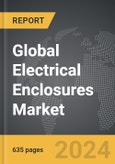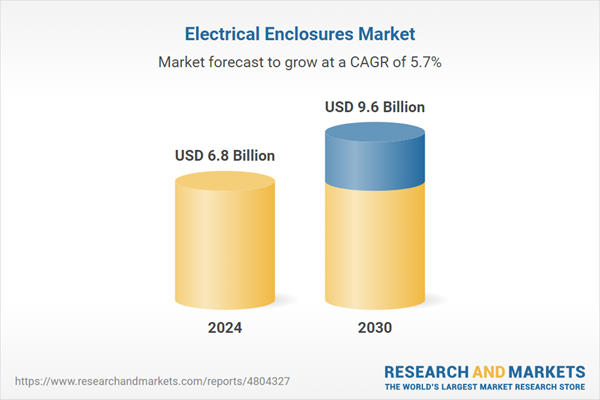Global Electrical Enclosures Market - Key Trends & Drivers Summarized
Electrical enclosures are vital components in various industries, serving to protect electrical equipment from environmental hazards and unauthorized access. These enclosures, typically made from materials like metal, plastic, or fiberglass, are designed to house electrical and electronic components such as switches, knobs, and displays, ensuring they operate safely and efficiently. The primary functions of electrical enclosures include safeguarding against dust, water, and other contaminants, as well as preventing electrical shocks and short circuits. They are used in a wide range of applications, from residential electrical panels to industrial control systems, and are essential for maintaining the integrity and reliability of electrical infrastructure.Advancements in materials science and manufacturing technologies have significantly influenced the design and functionality of electrical enclosures. Modern enclosures are engineered to meet stringent industry standards and certifications, such as NEMA and IP ratings, which specify the level of protection against environmental factors. Innovations like modular enclosures and customizable designs allow for greater flexibility and scalability in various applications. Additionally, the incorporation of advanced cooling solutions and thermal management systems has enhanced the performance of enclosures in high-heat environments, which is particularly important in sectors like data centers and telecommunications. The use of corrosion-resistant materials and coatings has also extended the lifespan of enclosures in harsh and corrosive environments, ensuring long-term durability and reliability.
The growth in the electrical enclosures market is driven by several factors. The rapid expansion of industrial automation and the increasing adoption of smart technologies in manufacturing processes have boosted the demand for advanced electrical enclosures that can support complex electrical systems. The rise in renewable energy installations, such as solar and wind farms, has further driven the need for robust enclosures capable of withstanding extreme weather conditions and protecting sensitive electrical components. Rising demand for electricity and the subsequent efforts of the power industry worldwide to expand generation capacity have been driving demand for electrical enclosures. A trend with significant implications for the market is the increasing power being generated by renewable sources of energy, specifically solar and wind power. Since renewable energy generation units involve the use of several sensitive electrical components as well as batteries that need to be protected to prevent system failures, the demand for electrical enclosures to ensure safety of the systems is on the rise. Rising demand for hygienic electrical enclosures in the food & beverage sector, given the enhanced emphasis on hygienic surroundings, sustained demand for robust enclosures from oil & gas, and metals & mining sectors, and the escalating needs of renewable energy sector are fueling market growth. Also, the growing emphasis on safety and regulatory compliance in both developed and emerging economies has led to increased investment in high-quality electrical enclosures. Urbanization and the expansion of infrastructure projects, including transportation and utilities, are also contributing to market growth. These factors, coupled with ongoing innovations in enclosure design and materials, are propelling the expansion of the electrical enclosures market, ensuring its critical role in safeguarding electrical systems across various industries.
Report Scope
The report analyzes the Electrical Enclosures market, presented in terms of units. The analysis covers the key segments and geographic regions outlined below.Segments: Material (Metallic, Non-Metallic); Mounting (Floor Mounted, Wall Mounted, Underground); End-Use (Power Generation & Distribution, Oil & Gas, Metals & Mining, Transportation, Other End-Uses).
Geographic Regions/Countries: World; USA; Canada; Japan; China; Europe; France; Germany; Italy; UK; Spain; Russia; Rest of Europe; Asia-Pacific; Australia; India; South Korea; Rest of Asia-Pacific; Latin America; Argentina; Brazil; Mexico; Rest of Latin America; Middle East; Iran; Israel; Saudi Arabia; UAE; Rest of Middle East; Africa.
Key Insights:
- Market Growth: Understand the significant growth trajectory of the Metallic segment, which is expected to reach US$6.0 Billion by 2030 with a CAGR of a 5.4%. The Non-Metallic segment is also set to grow at 6.2% CAGR over the analysis period.
- Regional Analysis: Gain insights into the U.S. market, valued at $2.1 Billion in 2024, and China, forecasted to grow at an impressive 8.8% CAGR to reach $1.9 Billion by 2030. Discover growth trends in other key regions, including Japan, Canada, Germany, and the Asia-Pacific.
Why You Should Buy This Report:
- Detailed Market Analysis: Access a thorough analysis of the Global Electrical Enclosures Market, covering all major geographic regions and market segments.
- Competitive Insights: Get an overview of the competitive landscape, including the market presence of major players across different geographies.
- Future Trends and Drivers: Understand the key trends and drivers shaping the future of the Global Electrical Enclosures Market.
- Actionable Insights: Benefit from actionable insights that can help you identify new revenue opportunities and make strategic business decisions.
Key Questions Answered:
- How is the Global Electrical Enclosures Market expected to evolve by 2030?
- What are the main drivers and restraints affecting the market?
- Which market segments will grow the most over the forecast period?
- How will market shares for different regions and segments change by 2030?
- Who are the leading players in the market, and what are their prospects?
Report Features:
- Comprehensive Market Data: Independent analysis of annual sales and market forecasts in US$ Million from 2024 to 2030.
- In-Depth Regional Analysis: Detailed insights into key markets, including the U.S., China, Japan, Canada, Europe, Asia-Pacific, Latin America, Middle East, and Africa.
- Company Profiles: Coverage of players such as Amphenol Corporation, CamdenBoss Ltd., Indelec SA, Connecticut Electric, Inc., Altech Corporation and more.
- Complimentary Updates: Receive free report updates for one year to keep you informed of the latest market developments.
Some of the 94 companies featured in this Electrical Enclosures market report include:
- Amphenol Corporation
- CamdenBoss Ltd.
- Indelec SA
- Connecticut Electric, Inc.
- Altech Corporation
- Ensto Group
- FactoryMation LLC
- Hammond Manufacturing Co., Ltd.
- Adalet
- Fibox Oy Ab
- Bud Industries Inc.
- Elettrocanali S.p.A.
- Eltech Australia Pty. Ltd.
- ISC Sales
- hA¤wa GmbH
Tariff Impact Analysis: Key Insights for 2025
Global tariff negotiations across 180+ countries are reshaping supply chains, costs, and competitiveness. This report reflects the latest developments as of April 2025 and incorporates forward-looking insights into the market outlook.The analysts continuously track trade developments worldwide, drawing insights from leading global economists and over 200 industry and policy institutions, including think tanks, trade organizations, and national economic advisory bodies. This intelligence is integrated into forecasting models to provide timely, data-driven analysis of emerging risks and opportunities.
What’s Included in This Edition:
- Tariff-adjusted market forecasts by region and segment
- Analysis of cost and supply chain implications by sourcing and trade exposure
- Strategic insights into geographic shifts
Buyers receive a free July 2025 update with:
- Finalized tariff impacts and new trade agreement effects
- Updated projections reflecting global sourcing and cost shifts
- Expanded country-specific coverage across the industry
Table of Contents
Companies Mentioned (Partial List)
A selection of companies mentioned in this report includes, but is not limited to:
- Amphenol Corporation
- CamdenBoss Ltd.
- Indelec SA
- Connecticut Electric, Inc.
- Altech Corporation
- Ensto Group
- FactoryMation LLC
- Hammond Manufacturing Co., Ltd.
- Adalet
- Fibox Oy Ab
- Bud Industries Inc.
- Elettrocanali S.p.A.
- Eltech Australia Pty. Ltd.
- ISC Sales
- hA¤wa GmbH
Table Information
| Report Attribute | Details |
|---|---|
| No. of Pages | 635 |
| Published | April 2025 |
| Forecast Period | 2024 - 2030 |
| Estimated Market Value ( USD | $ 6.8 Billion |
| Forecasted Market Value ( USD | $ 9.6 Billion |
| Compound Annual Growth Rate | 5.7% |
| Regions Covered | Global |









